Now that students got the chance to study at home full-time, the debate is on again regarding homeschooling. Learning at home offers its benefits, especially in parents being able to guide their children. In fact, it is a growing trend of education for families of all backgrounds to educate their children independently.
Given that schools have a massive environmental impact, parents need to consider homeschooling so they can also guide their children to a sustainable lifestyle.

To help you see whether homeschooling will work for your family, I prepared this comprehensive guide on homeschooling. I asked lifestyle bloggers, parents who homeschool their children, environmental experts, educators, and education industry insiders about education at home. Learn from their insights and get inspired to help students learn sustainably.
What Is Homeschooling?
According to Naomi Morris of ourkiwihomeschool.com, homeschooling is a way to give our children a great education tailored to their interests, abilities, and gifts. It’s also a way to increase our freedom and spend more time together as a family.
To Jessica Robinson from The Speaking Polymath, homeschooling is the mode of education in which parents teach their kids at home rather than sending them to a public or private school. It is one of the best modes of education, which can help parents save money and ensure that their children get the best access to learning according to their unique needs. Moreover, it also plays a vital role in strengthening the emotional bonding between parents and their kids.

For Imani Francies, a homeschooling parent and early childhood educator with US Insurance Agents, homeschool gives you the flexibility to better focus on your child’s learning style so you can better educate them.
To Denise Thomas, known as “Your Debt-Free College Coach,” homeschooling is an opportunity to teach your children in a way that is reflective of your values.
Why Do People Homeschool Their Children?
There are many reasons that people choose to homeschool their children.
Satisfying to watch and guide children’s learning
Naomi Morris says, “We enjoy being able to watch our children learn, developed, and grow. It’s really satisfying to teach your child how to read, for example.”
Freedom to choose the curriculum
She also adds that parents can choose their own curriculum in homeschooling, and there are many good ones out there. She uses the Charlotte Mason style of homeschooling, which includes a lot of art and hands-on learning. It’s a very practical teaching style.
Freedom of hours
For people who work at home (especially now in the time of lockdowns galore), the cinch to homeschool is the ability to set their own hours. It gives parents the freedom to do what they want when they want.
This way, children can be better educated at home. They get a lot of attention and can work at their own pace. They don’t get left behind, nor do they get bored because they’re ahead of the class.
Parents feel that their children aren’t getting the right kind of education

Eric Kim, the co-owner and Program Director of LA Tutors (an international private tutoring company), says that most of the time, it’s because they feel as though their children are not getting the right kind of education at traditional schools whether public or private. This can be due to several reasons, such as an intense athletics schedule that interferes with regular academics or simply because a student is too advanced for the public school curriculum and gets bored.
Safeguarding children
For Jessica Robinson, parents choose to homeschool to protect their children against bullying, all kinds of abuse, and other negative things that can happen in a school.
Parents know their children best
According to Miranda Yan of VinPit, parents get to understand the ability of their child. According to that, they can determine the child’s curriculum, and they can decide what your child studies, when they study it, and how long they study.
Imani Francies adds that other parents choose it to build a better relationship with their child and enhance improved interpersonal interactions.
To Denise Thomas, known as “Your Debt-Free College Coach“, people homeschool their children for such other reasons:
- To include a particular religious worldview in education
- To teach the child based on their learning style
- For a 1:1 tutoring style education which is proven to be higher quality
- To teach to the child’s interests or strengths
- To teach a more balanced view of history
Environmental Impact of Traditional School
Schools contribute hugely to environmental degradation in many ways:
Air Pollution
According to Jessica Robinson, schools contribute a major portion to environmental pollution. For example, school buses, electric generators, and other electronic devices in schools lead to air pollution.
Imani Francies notes that many chemicals found in pesticides and cleaning products that school janitorial staff sure are not only unsafe and harmful to children if inhaled or if there’s skin contact, but it can also be particularly harmful to the environment. It has an impact on both the interior and outdoor environment and the potential for pollution and waste.
Paper and food waste
Jessica Robinson adds, every year, schools generate huge masses of paper and food wastes that are very harmful to the environment. Not only all this waste very costly, but they also endanger the environment through pollution.
Resource-intensive processes
Traditional schools, Naomi Morris says, require A LOT of resources. So there’s a lot of energy that goes into getting everyone there and back again and running the huge buildings themselves.
Miranda Yan also said that schools consume a lot of energy and generate a lot of heat, which results in carbon emissions. The ecology is also impacted by the excessive use of paper, printed materials and the dematerialization effect of using ICTs. A large number of pupils rely on scarce resources.
Homeschooling vs. Traditional School: Pros and Cons
Homeschooling
Pros
- Let them get ahead in the areas they’re good at while going slower through the subjects they struggle with
- Homeschoolers tend to behave in all environments better since their parents can immediately correct unwelcome behavior.
- Parents can customize the curriculum so that their child can excel in areas and stay challenged, all in a flexible schedule that fits their needs.
- No rush: Parents and children who homeschool do not have to adhere to the rigid schedules that traditional schools impose.
- Less distractions, the better quality of education
- Homeschoolers tend to interact with all ages throughout their homeschooling thus, there is a much easier transition into the workforce with the ability to communicate with all ages.
- Less contact with bullying and less contact with peer pressure about smoking, drinking alcohol, and drug use.
Cons
- It requires a lot of effort and discipline to do it well. You don’t get many breaks from the kids
- It can be expensive to buy everything you need.
- Homeschooling may limit the child’s exposure to extra-curricular activities.
- May hamper a child’s social development for children in such that kids might grow up in a confined ecosystem without friends or social contact.
Traditional School
Pros
- According to Eric Kim, the obvious pros to traditional school are the social benefits. Homeschooling children can be isolating and slow social development, especially at a younger age. If you are going to homeschool your child(ren), you must find ways to supplement their social development and growth.
- This education system is pre-planned and well organized. Includes facilities like a formal classroom, teachers and promotes extracurricular activities, including sports.
- For Miranda Yan, students are molded and prepared for a successful future by vigorous disciplinary and punctuality activities.
- To Imani Francies, the pros of traditional school are having access to libraries and research materials, having a scheduled learning system (though every scholar does not work best with this), and your child can easily connect with extra-curricular activities.
Cons
- It is expensive with high tuition fees and other charges.
- Students are passive listeners, and their participation is reduced to asking questions.
- Traditional schools include a lack of adequate supervision and independent assistance (especially in high-capacity classrooms), no flexibility in study hours, scholar-to-scholar interactions are limited, and risk of bullying and abuse.
- In a traditional school, the children remain with the same age for 12 years. However, this is not ‘real-life.’ When entering the workforce, there are co-workers and management of all ages. Therefore, the student needs to be able to communicate with all ages and on various topics that are not possible in traditional school.
Homeschooling Requirements
Patience
A willingness to learn alongside your children is key to homeschooling. Kids are mischievous in nature. It needs a lot of patience to handle them and direct their attention towards learning. So, parents should choose to homeschool only if they have nearly infinite patience to handle their children’s mischief and tantrums – with a calm demeanor. Otherwise, kids develop the risk of becoming emotionally closed down.
Discipline
Parents have to be disciplined regarding their child’s education. Only then can homeschooling become a success.
Time
To educate children well at home, time is a basic requirement. If parents have a busy lifestyle, they cannot make proper time for their kids’ education. So, parents should go for homeschooling only if they can fulfill this requirement.
Abide by state laws
Each state has its own set of homeschooling laws, and you must abide by them or risk being prosecuted. For example, in Georgia, education is required for children aged six to 16. Beginning in third grade, they must be tested every three years. Reading, language arts, mathematics, social studies, and science are among the subjects they must learn.
Requirements vary with each state, with some being more ‘homeschool friendly’ than others. Some states require registration but have no educational checkpoints. Some states have minimal checkpoints, such as requiring year-end exams to ensure a specific grade level before the next year of homeschooling is approved.
Teaching capacity
Parents must have a high school diploma or GED and complete an online statement of intent to homeschool their children.
Other homeschooling requirements include:
- Homeschool curriculum
- Homeschooling space
- Funds
- Homeschooling materials
- Registration(not applicable to all)
How to Get Started With Homeschooling
All learning starts at home. So homeschooling is merely a continuation of what all parents do from the beginning. Here are some tips for you to get started from experts in this field:
Connect with parents who already homeschool their kids
Jessica Robinson: Experience is the best teacher. So, one of the best ways to start with homeschooling is to get in touch with parents who are already homeschooling their kids. This will help you get familiar with the basics of homeschooling and begin with the best preparation.
Melanie Musson: When you’re considering homeschooling, join a local Facebook homeschool group. There, you’ll be able to ask questions about requirements, find like-minded parents to partner with, and learn about available co-ops to join.
Know your state’s homeschooling laws
Jessica Robinson: Different states have different rules regarding homeschooling. Some require you to notify the school district that you are homeschooling. Some need testing and keeping a record of your child’s attendance, etc. So, to get started with homeschooling, you must know your state’s homeschooling laws.
Denise Thomas: Since every state has differing rules it is best to check in with your state homeschooling group to know what is required. Unfortunately local schools and school districts, and sometimes state school entities will give wrong or misguided information based on their own prejudices.
Customize your curriculum
Naomi Morris: Once children hit traditional school age, you will need to decide on a curriculum. Facebook groups are an excellent place to find out the pros and cons of all the different options.
Jessica Robinson: After completing all the basics (reading, writing, and phonetics), it is important to explore your child’s interests and design a suitable curriculum.
Create a daily time table for your child
Jessica Robinson: Depending upon your child’s preferences, you can design a daily timetable for him. You can make sure that the timetable ensures maximum comfort for your child while meeting his productive zone. The productive zone is the time of the day when your child usually exhibits maximum concentration and engrossment towards learning.
For homeschooling success, you need to be flexible according to your child’s needs. You can decide the school timings concerning the preferences of your child.
For effective learning, the presence of a learning environment is a must. So, you should try to create a proper learning space for your child. Whenever your child sits in his learning area, his attention will naturally turn towards studies.
To help your child be serious about homeschooling, you can involve him in the process of creating a timetable. If he creates a timetable for himself, his chances of sticking to it will increase significantly.
Imani Francies: Create a designated learning space. You can map out the school year ahead of time so you can know how to track your child’s progress. Plan out your academic year to keep track of your goals and important tasks by breaking down large objectives and tasks into smaller parts. This makes them easier to handle, and you’re less likely to overlook things.
Experiment with different teaching styles
Jessica Robinson: To teach your child in the best possible way, it is crucial to experiment with different teaching styles and find what works the best for your child. You can try active learning strategies, blended learning, and other modes of learning before finalizing a mode that suits the best for your child.
Homeschooling methods
Homeschooling is complex, with a wide variety of methods you can use to guide your children. According to Imani Francies, the best approach to identify why you homeschool and what this will accomplish for your family is to educate yourself about these numerous options. Your state’s requirements will also help you find the best method as well.
Charlotte Mason method
There are a lot of activities involving drawing and coloring. When teaching concepts, they use great real-world stories, often involving nature, family, and animals. It concentrates on literature and living books rather than answering questions from textbooks.
Traditional Homeschooling
Traditional homeschooling involves teaching kids at home by employing methods that are
implemented at public and private schools. Here timetables are arranged, and the child works on the assigned topic.
Classical Homeschooling
This employs the instructional method developed by Latin writer Martianus Capella. This instructional method is centered around appropriately training the mind. It is divided into three stages according to age, and each focuses on various topics within the stages.
Homeschooling with unit studies
The unit studies method of homeschooling involves combining multiple subjects with learning about a particular topic. For example, you can combine science, geography, and English with teaching your child about topics like the weather.
The un-schooling
This method goes with the interest of the child.
Free-style engagement
For Sacha El-Haj of 8 Miles from Home, it goes beyond teaching stories to our young children and teach them how to write alphabets, read words, and phonetics with workbooks.
She says, “We teach Story how to cook, the health benefits of the foods and ingredients we use. Once, she asked us to teach her how eyes see. So we watched a program together about it, then paused it and asked her to explain what she understands and what she doesn’t. Other times we just teach her about the ocean and environmental issues. There are many elements to it, but in reality, we just take time to engage with what she’s interested in learning at times and then guide her along that path. Much like the Montessori and Waldorf teaching methods.”
Co-ops
Co-ops can help your children become accustomed to traditional classes and can help supplement your teaching, especially in subjects where you lack expertise and confidence.
Tips to make homeschooling zero waste
Homeschooling, like any other routine in human life, can be zero waste. In fact, doing it with less waste opens up avenues for creativity, saving money, and fun family bonding. Here are some expert tips on a more sustainable homeschooling session:
Avoid buying new as much as possible
Imani Francies: For all of us to be zero-waste as possible as we can, you should not buy anything if you can help it. Make your bread, detergent, and other household needs instead of buying them. It can double as home economics and science lessons, all while reducing waste. Instead of buying textbooks and paper curriculums, use digital versions, check out books from your local library, or borrow them.
Naomi Morris: Recycling the curriculum for multiple children is one way to reduce waste. Many of our activities are laminated and re-used again and again.
Go online
Naomi Morris: You can also download and print the curriculum yourself at home, so you don’t have to ship it!
Jessica Robinson: Online resources can help you teach your child in the best possible way. You can make him see things happening before his eyes with the help of educational videos available on YouTube. Moreover, online resources can help you save paper and go zero-waste in homeschooling. You won’t need to buy textbooks for your child. Instead, you can utilize e-books and online resources for homeschooling.
Imani Francies: Another major way to stay successful is by doing the majority of homeschooling online. Keep digital textbooks and learn with video documentaries, movies, and virtual literature instead of paper versions of these items.
Use paper less
Melanie Musson: While the paper is necessary for school, you can also use dry-erase boards to practice handwriting and use both sides of the paper to maximize its purpose. You can even compost the paper instead of sending it to the landfill.
Jessica Robinson: For some things like note-making, the use of paper is necessary. But, you should try to minimize it. Moreover, you can also encourage your child to utilize each page of his notebooks. This way, you can easily go zero-waste in homeschooling.
Switch to reusables
Miranda Yan: Use pencils or ink pens that can be refilled.
Get creative with the curriculum
Denise Thomas: With multiple children of differing ages, some curriculums cover several grades in one, thus reducing the amount of curriculum necessary. I also found that I could use the same textbooks and workbooks or tests for the next child, even if they were five years apart.
Reduce waste and energy use at home
Melanie Musson: You can make home-cooked meals and avoid pre-packaged lunches. Composting is an easy way to reduce waste throughout your day. In addition, you can choose alternative energy sources to supplement your electricity consumption.
What should you buy for zero waste homeschooling?
If you want to buy eco-friendly school supplies for homeschooling, here are some expert-approved items:
Timeless student activities and tools
Reusable activities and learning tools are good for reducing waste, Naomi Morris says.
Plantable stationery
Andrew Groves of goBambu: There are many stationery items that can be replaced with something more eco-friendly and these days you can even get your hands on pencils that can be planted and grown into herbs, vegetables and flowers.
Jessica Robinson: Plantable pencils are capped with a biodegradable seed capsule. Once you use your pencil completely, you can put it in soil as per the instructions provided with it and turn your pencil into a plant. By using these pencils for homeschooling, you can get beautiful plants for home decor for free.
Fountain pens
Jessica Robinson: Fountain pens can help you reduce plastic waste and go eco-friendly with homeschooling. You can refill these pens with the help of an ink pot.
Tablets
Jessica Robinson: By using tablets for processes like note making, you can cut off on paper usage and go eco-friendly with homeschooling.
Get supplies that are durable
Melanie Musson: Purchase metal scissors, rulers, protractors, and other supplies. They’ll
last through all your children, and you’ll avoid using plastics.
Should Parents Consider Homeschooling?
For Jessica Robinson, parents should consider homeschooling their kids if they can fulfill the requirements. This is because homeschooling offers multifarious benefits. Better emotional understanding between parents and kids, lesser expenses, flexibility, and customization of education according to the child’s interests and needs are some examples.
According to Denise Thomas, many homeschooling parents believe that the public school curriculum does not provide their children with the necessary information and abilities. Finally, home-schooled children tend to perform better on state and federal standardized examinations.
Miranda Yan notes that only parents have the authority to determine what is best for their children. So, if you match the standards and are aware of the benefits and drawbacks, you should consider homeschooling.
Eric Kim says, homeschooling is not for everyone, but if you feel like your needs are not being met by traditional schooling, homeschooling may be an option. Usually, this means one or both parents are dedicated to managing the curriculum and overseeing the academic development of their child(ren). If that’s not possible, one or more dedicated professional tutors can also assist with homeschooling needs.
Naomi Morris says it best: “It’s hard work, but the rewards are worth it.”
Conclusion
Ultimately, your children’s education depends on your situation and your kids’ learning style. Whatever educational style you choose, always do it with less waste so that students can also see how sustainable living plays out in reality.




